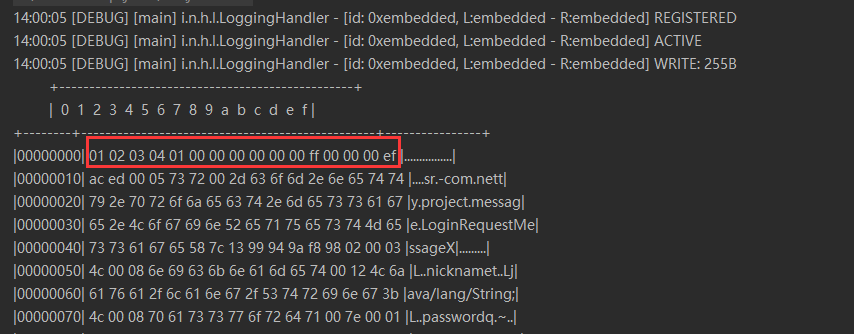TCP/IP 中消息传输基于流的方式,没有边界。如果不约定或者划定边界,就会造成消息黏包或者半包现象的发生,因此我们需要指定协议。协议的目的就是划定消息的边界,制定通信双方要共同遵守的通信规则。比如熟悉的应用层的http请求就是有http协议。
1-自定义协议
一般自定义协议包含以下几个要素:
魔数:用来在第一时间判定是否是无效数据包,比如Java的class文件,开头几个字节就是表示Java魔数的。
版本号:可以支持协议的升级;
序列化算法:消息正文到底采用哪种序列化反序列化方式,可以由此扩展,例如:json、protobuf、hessian、jdk;
指令类型:比如是登录、注册、单聊、群聊... 跟业务相关;
请求序号:为了双工通信,提供异步能力;
正文长度
消息正文
2-自定义消息编解码协议
import com.netty.project.message.Message;
import io.netty.buffer.ByteBuf;
import io.netty.channel.ChannelHandlerContext;
import io.netty.handler.codec.ByteToMessageCodec;
import lombok.extern.slf4j.Slf4j;
import java.io.ByteArrayInputStream;
import java.io.ByteArrayOutputStream;
import java.io.ObjectInputStream;
import java.io.ObjectOutputStream;
import java.util.List;
@Slf4j
public class MessageCodec extends ByteToMessageCodec<Message> {
@Override
public void encode(ChannelHandlerContext ctx, Message msg, ByteBuf out) throws Exception {
// 1. 魔数-4 字节的
out.writeBytes(new byte[]{1, 2, 3, 4});
// 2. 版本-1 字节的
out.writeByte(1);
// 3. 序列化方式-1 字节的 jdk 0 , json 1
out.writeByte(0);
// 4. 指令类型-1 字节的
out.writeByte(msg.getMessageType());
// 5. 4 个字节
out.writeInt(msg.getSequenceId());
// 无意义,对齐填充
out.writeByte(0xff);
// 6. 获取内容的字节数组
ByteArrayOutputStream bos = new ByteArrayOutputStream();
ObjectOutputStream oos = new ObjectOutputStream(bos);
oos.writeObject(msg);
byte[] bytes = bos.toByteArray();
// 7. 长度
out.writeInt(bytes.length);
// 8. 写入内容
out.writeBytes(bytes);
}
@Override
protected void decode(ChannelHandlerContext ctx, ByteBuf in, List<Object> out) throws Exception {
int magicNum = in.readInt();
byte version = in.readByte();
byte serializerType = in.readByte();
byte messageType = in.readByte();
int sequenceId = in.readInt();
in.readByte();
int length = in.readInt();
byte[] bytes = new byte[length];
in.readBytes(bytes, 0, length);
ObjectInputStream ois = new ObjectInputStream(new ByteArrayInputStream(bytes));
Message message = (Message) ois.readObject();
log.debug("magicNum={}, version={}, serializerType={}, messageType={}, sequenceId={}, length={}", magicNum, version, serializerType, messageType, sequenceId, length);
log.debug("message={}", message);
out.add(message);
}
}
ByteToMessageCodec的子类不能添加@ChannelHandler.Sharable注解,因为在编解码过程中存在中间状态,可能造成消息编解码出错...
编解码器,何时添加@ChannelHandler.Sharable被共享?
当 handler 不保存状态时,就可以安全地在多线程下被共享
但要注意对于编解码器类,不能继承 ByteToMessageCodec 或 CombinedChannelDuplexHandler 父类,他们的构造方法对 @Sharable 有限制
如果能确保编解码器不会保存状态,可以继承 MessageToMessageCodec 父类
下面这个MessageCodecSharable可以添加@ChannelHandler.Sharable的原因是:
在client端和server端配合了LengthFieldBasedFrameDecoder
到达这个编解码的消息已经经过了LengthFieldBasedFrameDecoder
完全转化成为我们需要的消息,不存在中间状态...
必须配合LengthFieldBasedFrameDecoder使用
client:
NioEventLoopGroup group = new NioEventLoopGroup();
LoggingHandler LOGGING_HANDLER = new LoggingHandler(LogLevel.DEBUG);
MessageCodecSharable MESSAGE_CODEC = new MessageCodecSharable();
try {
Bootstrap bootstrap = new Bootstrap();
bootstrap.channel(NioSocketChannel.class);
bootstrap.group(group);
bootstrap.handler(new ChannelInitializer<SocketChannel>() {
@Override
protected void initChannel(SocketChannel ch) throws Exception {
ch.pipeline().addLast(new LengthFieldBasedFrameDecoder(
1024, 0, 4, 0,0));//in
ch.pipeline().addLast(LOGGING_HANDLER);//in-out
ch.pipeline().addLast(MESSAGE_CODEC);//in-out
server:
NioEventLoopGroup boss = new NioEventLoopGroup();
NioEventLoopGroup worker = new NioEventLoopGroup();
LoggingHandler LOGGING_HANDLER = new LoggingHandler(LogLevel.DEBUG);
MessageCodecSharable MESSAGE_CODEC = new MessageCodecSharable();
try {
ServerBootstrap serverBootstrap = new ServerBootstrap();
serverBootstrap.channel(NioServerSocketChannel.class);
serverBootstrap.group(boss, worker);
serverBootstrap.childHandler(new ChannelInitializer<SocketChannel>() {
@Override
protected void initChannel(SocketChannel ch) throws Exception {
ch.pipeline().addLast(new LengthFieldBasedFrameDecoder(
1024, 0, 4, 0,0));
ch.pipeline().addLast(LOGGING_HANDLER);
ch.pipeline().addLast(MESSAGE_CODEC);import com.netty.project.message.Message;
import io.netty.buffer.ByteBuf;
import io.netty.channel.ChannelHandler;
import io.netty.channel.ChannelHandlerContext;
import io.netty.handler.codec.MessageToMessageCodec;
import lombok.extern.slf4j.Slf4j;
import java.io.ByteArrayInputStream;
import java.io.ByteArrayOutputStream;
import java.io.ObjectInputStream;
import java.io.ObjectOutputStream;
import java.util.List;
@Slf4j
@ChannelHandler.Sharable
/**
* 必须和 LengthFieldBasedFrameDecoder 一起使用,确保接到的 ByteBuf 消息是完整的
*/
public class MessageCodecSharable extends MessageToMessageCodec<ByteBuf, Message> {
@Override
protected void encode(ChannelHandlerContext ctx, Message msg, List<Object> outList) throws Exception {
ByteBuf out = ctx.alloc().buffer();
// 1. 4 字节的魔数
out.writeBytes(new byte[]{1, 2, 3, 4});
// 2. 1 字节的版本,
out.writeByte(1);
// 3. 1 字节的序列化方式 jdk 0 , json 1
out.writeByte(0);
// 4. 1 字节的指令类型
out.writeByte(msg.getMessageType());
// 5. 4 个字节
out.writeInt(msg.getSequenceId());
// 无意义,对齐填充
out.writeByte(0xff);
// 6. 获取内容的字节数组
ByteArrayOutputStream bos = new ByteArrayOutputStream();
ObjectOutputStream oos = new ObjectOutputStream(bos);
oos.writeObject(msg);
byte[] bytes = bos.toByteArray();
// 7. 长度
out.writeInt(bytes.length);
// 8. 写入内容
out.writeBytes(bytes);
outList.add(out);
}
@Override
protected void decode(ChannelHandlerContext ctx, ByteBuf in, List<Object> out) throws Exception {
int magicNum = in.readInt();
byte version = in.readByte();
byte serializerType = in.readByte();
byte messageType = in.readByte();
int sequenceId = in.readInt();
in.readByte();
int length = in.readInt();
byte[] bytes = new byte[length];
in.readBytes(bytes, 0, length);
ObjectInputStream ois = new ObjectInputStream(new ByteArrayInputStream(bytes));
Message message = (Message) ois.readObject();
log.debug("magicNum={}, version={}, serializerType={}, messageType={}, sequenceId={}, length={}", magicNum, version, serializerType, messageType, sequenceId, length);
log.debug("message={}", message);
out.add(message);
}
}魔数4字节+版本-1 字节+序列化方式-1 字节+ 指令类型-1 字节+请求序号-4字节+消息长度-4字节=15字节;一般设计成2的整数倍。2^4=16字节,所以中间填充一个字节
测试代码:
import com.netty.project.message.LoginRequestMessage;
import com.netty.project.protocol.MessageCodec;
import io.netty.channel.embedded.EmbeddedChannel;
import io.netty.handler.codec.LengthFieldBasedFrameDecoder;
import io.netty.handler.logging.LoggingHandler;
public class MessageCodecTest {
public static void main(String[] args) throws Exception{
EmbeddedChannel channel = new EmbeddedChannel(
new LoggingHandler(),
new LengthFieldBasedFrameDecoder(
1024, 12, 4, 0, 0),
new MessageCodec()
);
// encode
LoginRequestMessage message = new LoginRequestMessage("zhangsan", "123", "张三");
channel.writeOutbound(message);
}
}

01 02 03 04:魔数
01 :版本号
00 :序列化方式
00 :指令类型
00 00 00 00:请求序号
ff :对齐填充
00 00 00 ef:消息正文长度(e=14,f=15)14*16+15=239直接+协议上面16=255
























 1317
1317

 被折叠的 条评论
为什么被折叠?
被折叠的 条评论
为什么被折叠?








